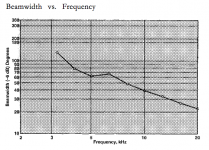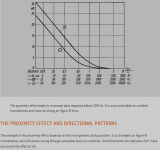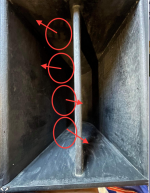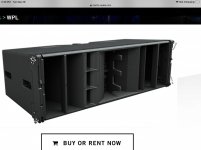Hi everyone. I’ve been building a high end PA system in the past few weeks. Ultimately it’s more or less a copy of the pm90 but using bigger driver. Instead of the 12 inch woofer I’m using 2 15 inch B&c 15nw76. I’ve also decided to use a bms 4599he coupled with 4 ciare ct440 super tweeters. I’m still waiting on my bms 4599he as it’s being build, but almost everything is done except for a few touches. I have been contemplating a few ways on how to mount the 4 super tweeters. Given the limited space I have left, I was thinking of just mounting them one on top of they other. The only problem I’m running into is, coverage. Ciare has not shown it’s of axis response nor its coverage pattern. So coverage might be limited if it’s all on the same horizontal axis. On a side note, I’ve built a 90x40 horn for the bms 4599he. So ultimately I would want the coverage pattern on the tweeter to be quite similar. Any suggestions? Additionally, I’m not exactly sure of the built quality of my horn for the bms4599he. The horn sensitivity is obviously a big concern as it’s meant for pro applications. It also need to be able to play at least down to 650hz where it will be crossing with the 15inch woofer. Any suggestions would be much appreciated. Thx
Attachments
-
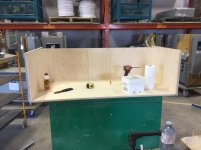 4B724502-F179-4792-828B-CF90265627BD.jpg752.9 KB · Views: 385
4B724502-F179-4792-828B-CF90265627BD.jpg752.9 KB · Views: 385 -
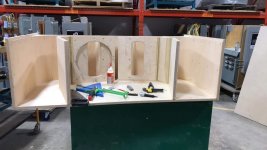 46E01991-3410-48BF-816E-BA3BCD2EB391.jpeg269.4 KB · Views: 348
46E01991-3410-48BF-816E-BA3BCD2EB391.jpeg269.4 KB · Views: 348 -
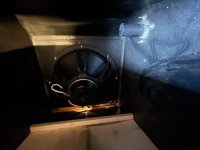 6B73B348-8D4E-4F5D-B7EB-FAB1C41AEA73.jpg904.6 KB · Views: 211
6B73B348-8D4E-4F5D-B7EB-FAB1C41AEA73.jpg904.6 KB · Views: 211 -
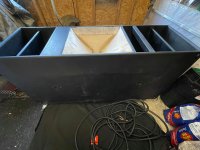 6BB6950B-734D-46CC-907D-A5BEFD8C18DA.jpg989.7 KB · Views: 342
6BB6950B-734D-46CC-907D-A5BEFD8C18DA.jpg989.7 KB · Views: 342 -
 4667B27A-112D-403A-8039-DDD19888438A.jpg656.8 KB · Views: 347
4667B27A-112D-403A-8039-DDD19888438A.jpg656.8 KB · Views: 347 -
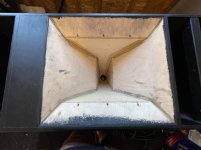 B5D96CE6-AD2A-4EB0-B321-B23A77131AEF.jpg1,010 KB · Views: 354
B5D96CE6-AD2A-4EB0-B321-B23A77131AEF.jpg1,010 KB · Views: 354
The Peavey 1210 PA speaker had 3 mallory crystal tweeters pointed in 3 directions at the top. Good dispersion.
The Peavey SP2 speaker line has a horn to disperse the highs over a wide area, and point it down so they cover the floor from stands near the ceiling. See SP2-XT datasheet. Even coverage over 90 degrees at most frequencies makes a speaker pleasant to hear.
Be sure to measure response for frequency. I've heard some home build 4 way speakers and they sounded awful. They were not measured, or adjusted. Just assembled. Measuring mikes are cheap now and software will run on a PC or laptop. If you don't have an anechoic camber (few do) do the measurements outside in a yard at a quiet minute.
The Peavey SP2 speaker line has a horn to disperse the highs over a wide area, and point it down so they cover the floor from stands near the ceiling. See SP2-XT datasheet. Even coverage over 90 degrees at most frequencies makes a speaker pleasant to hear.
Be sure to measure response for frequency. I've heard some home build 4 way speakers and they sounded awful. They were not measured, or adjusted. Just assembled. Measuring mikes are cheap now and software will run on a PC or laptop. If you don't have an anechoic camber (few do) do the measurements outside in a yard at a quiet minute.
Thx 🙏Looks like we don't have a lot of PA fans here. Let's put it in the PA section.
That's a complex build, Kudos.
Looks like we don't have a lot of PA fans here. Let's put it in the PA section.
That's a complex build, Kudos.
Thx a lot.
Hey. I currently only have an rta mic for my dbx drive rack. Any recommendations for a good mic and a good software. ThxThe Peavey 1210 PA speaker had 3 mallory crystal tweeters pointed in 3 directions at the top. Good dispersion.
The Peavey SP2 speaker line has a horn to disperse the highs over a wide area, and point it down so they cover the floor from stands near the ceiling. See SP2-XT datasheet. Even coverage over 90 degrees at most frequencies makes a speaker pleasant to hear.
Be sure to measure response for frequency. I've heard some home build 4 way speakers and they sounded awful. They were not measured, or adjusted. Just assembled. Measuring mikes are cheap now and software will run on a PC or laptop. If you don't have an anechoic camber (few do) do the measurements outside in a yard at a quiet minute.
That is a beastie.
I remember my first mobile disco speaker which was 4 off Fane 12-50WRMS in a 4 by 12 cabinet. Sounded great but it wouldnt fit in the car !
So cut it down the middle and made 2 off 2 by 12 cabinets.
One way of doing the tweeters is to put them on a semi circle to get good dispersion.
I remember my first mobile disco speaker which was 4 off Fane 12-50WRMS in a 4 by 12 cabinet. Sounded great but it wouldnt fit in the car !
So cut it down the middle and made 2 off 2 by 12 cabinets.
One way of doing the tweeters is to put them on a semi circle to get good dispersion.
Most people recommend the parts-express mike & software: OmniMic V2 and DATS V3 Dayton Audio Speaker Measurement BundleHey. I currently only have an rta mic for my dbx drive rack. Any recommendations for a good mic and a good software. Thx
I was going to use a shure KSM27 mike which is specified +-5 db 20 hz-15 khz. but the two I found were carried off by the burglar 9/20, along with the shure v15 test record. Time for another 40 year search. Lots of ****ese copies, no specifications you can trust. AT4033 may be more available. Both condenser mikes require a mixer with phantom power.
Audacity software records through the mike jack of a PC, free. Plotting result is up to me.
Michael,Hey. I currently only have an rta mic for my dbx drive rack. Any recommendations for a good mic and a good software. Thx
Assuming you have the dbx RTA-M, and it's response is as specified, no need to buy another. Only omnidirectional mics should be used for speaker testing.
REW
REW - Room EQ Wizard Room Acoustics Software
is a good (and free) software.
"Bullet" tweeters like the Ciare ct440 have progressively narrowing response as frequency progresses upwards, I'd expect response similar to the JBL 2402, about 40 degrees at 10kHz.
Art
Attachments
That doesn't make sense to me.Only omnidirectional mics should be used for speaker testing.
I can see using an omni mike for testing room response.
I'm going to test a 2 way speaker outside. I intended to put the mike a meter or two out front of the drivers, centered. I don't want to hear any reflection from the parallel board fence 40' to the right or the hum of the exhaust fan at the bar 800' in front of the speaker. I was going to use a cardioid mike.
Last edited:
Indianajo,That doesn't make sense to me.
I was going to use a cardioid mike.
Cardioid microphone response varies with proximity (distance) to the source, not appropriate for speaker testing.
A cardiod mic at an appropriate testing distance (meters) will have severely reduced low frequency response compared to a centimeters distance.
Art
Attachments
Last edited:
Thank you very much. Eq wizard does seem like a really good software especially for free. Similar response to the jbl 2402 makes a lot of sense. If it was your build what would you do? A sort of j-shaped arch for the tweeters could be interesting. But I would also have to point at least two tweeters to different sides for optimal horizontal coverage. Say first one at the bottom straight pointing slightly down. next one up to the left (not exactly sure of the angle yet), and then the third one up to the right (would have to be at same angle as the previous one) and last one straight forward. What do you think?Michael,
Assuming you have the dbx RTA-M, and it's response is as specified, no need to buy another. Only omnidirectional mics should be used for speaker testing.
REW
REW - Room EQ Wizard Room Acoustics Software
is a good (and free) software.
"Bullet" tweeters like the Ciare ct440 have progressively narrowing response as frequency progresses upwards, I'd expect response similar to the JBL 2402, about 40 degrees at 10kHz.
Art
That doesn't make sense to me.
I can see using an omni mike for testing room response.
I'm going to test a 2 way speaker outside. I intended to put the mike a meter or two out front of the drivers, centered. I don't want to hear any reflection from the parallel board fence 40' to the right or the hum of the exhaust fan at the bar 800' in front of the speaker. I was going to use a cardioid mike.
Omnis are standard for various reasons, including, precisely, being omni so no lobing or response varying with (microphone) angle, they are flatter, but main reason is that you want sound pressure at a given *point* , and I mean the geometrical definition of a point, as "a dimensionless point in space" and thus open and equally responsive to waveforms coming from any direction.
Consider a point as infinitely small.
That´s why old (think 40´s) 1" capsules gave way to 1/2" and so on.
I think currently they are available down to 1/8", go figure, although larger ones are normally used ... if anything for practical reasons.
Michael,If it was your build what would you do? A sort of j-shaped arch for the tweeters could be interesting. But I would also have to point at least two tweeters to different sides for optimal horizontal coverage. Say first one at the bottom straight pointing slightly down. next one up to the left (not exactly sure of the angle yet), and then the third one up to the right (would have to be at same angle as the previous one) and last one straight forward. What do you think?
If it was my build along your design parameters, I'd have chosen a co-ax HF driver rather than separate mid-hi horns.
I'd also arrange the cabinet in the opposite orientation, so the low output horn exits are above and below the high output, rather than side by side.
Any array of multiple devices without constant directivity throughout their pass-band and not originating from the same virtual point source will be a compromise in the placement of peaks and nulls, "comb filtering".
Assuming you are still going with the same orientation as depicted, a sort of "barber pole" vertical tweeter arrangement mounted on the inner bass horn stiffener would probably be as "good as it gets" in an attempt to match the mid horn's dispersion.
Using 48 dB per octave crossovers will reduce the low/mid and mid/high comb filtering to a smaller frequency range.
Art
Attachments
Last edited:
This tweeter should have similar dispersion to your bullets:
https://jblpro.com/en/site_elements/2402h-information
I would array them such that the array matches the mid horn dispersion at the crossover frequency and that they don't comb filter at this frequency. Accepting the limitation that the high frequency pattern will have 'fingers' from the collapsing dispersion.
https://jblpro.com/en/site_elements/2402h-information
I would array them such that the array matches the mid horn dispersion at the crossover frequency and that they don't comb filter at this frequency. Accepting the limitation that the high frequency pattern will have 'fingers' from the collapsing dispersion.
Thank you very much for your help. Would it be worthwhile orienting my speaker vertically instead of horizontally? If I do so, I would have to re do my exponential horn as the coverage would no more be suitable. I’m a bit confused Regarding your idea for a barber pole inside the inner bass horn. Wouldn’t it be best if the tweeters were closer to the mid range horn in the middle, rather than on the side in the mid bass ports for the 15inch woofers? I suspect that the pressure coming out of these horns would distort the sound? On the other hand, this got me thinking of maybe trying out another way to couple the bms 4599he with the 4 tweeters. Would it possible to design a synergy horn (would be placed in the middle where I already have a mid range horn for the bms driver). The bms 4599he would still be place right at the apex of the synergy horn, but the ciare tweeters would be mounted on each corners of the synergy horn in a way so that it matches the same dispersion. You also mentioned using coax compression driver instead. I’ve actually thought about doing this. My only concern was output. The extra output of separating both drivers to me seemed to be worth it as Im trying to use only a pair of speaker to replace a stack of line array. Ps I really appreciate your help. This is actually my first pa speaker project. Me and my brother have been working on this build. It’s more a goal of mine to make my own speaker.Michael,
If it was my build along your design parameters, I'd have chosen a co-ax HF driver rather than separate mid-hi horns.
I'd also arrange the cabinet in the opposite orientation, so the low output horn exits are above and below the high output, rather than side by side.
Any array of multiple devices without constant directivity throughout their pass-band and not originating from the same virtual point source will be a compromise in the placement of peaks and nulls, "comb filtering".
Assuming you are still going with the same orientation as depicted, a sort of "barber pole" vertical tweeter arrangement mounted on the inner bass horn stiffener would probably be as "good as it gets" in an attempt to match the mid horn's dispersion.
Using 48 dB per octave crossovers will reduce the low/mid and mid/high comb filtering to a smaller frequency range.
Art
When building this speaker I was inspired by this design.Michael,
If it was my build along your design parameters, I'd have chosen a co-ax HF driver rather than separate mid-hi horns.
I'd also arrange the cabinet in the opposite orientation, so the low output horn exits are above and below the high output, rather than side by side.
Any array of multiple devices without constant directivity throughout their pass-band and not originating from the same virtual point source will be a compromise in the placement of peaks and nulls, "comb filtering".
Assuming you are still going with the same orientation as depicted, a sort of "barber pole" vertical tweeter arrangement mounted on the inner bass horn stiffener would probably be as "good as it gets" in an attempt to match the mid horn's dispersion.
Using 48 dB per octave crossovers will reduce the low/mid and mid/high comb filtering to a smaller frequency range.
Art
Attachments
- Home
- Live Sound
- PA Systems
- DIY PA system
